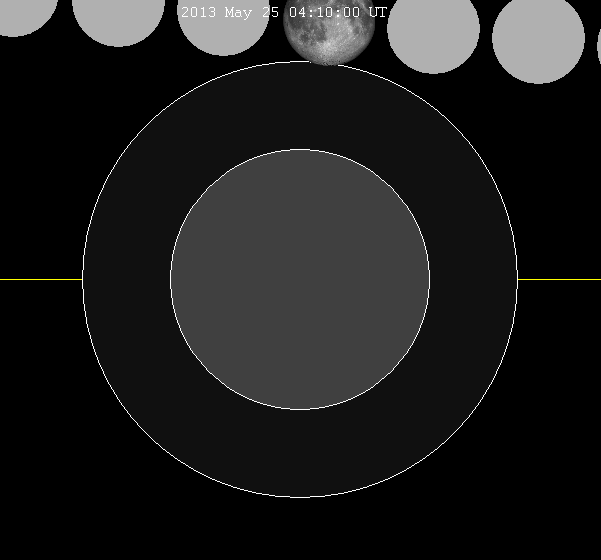THE SOUTHWORTH PLANETARIUM
70 Falmouth Street Portland,Maine 04103
(207) 780-4249 usm.maine.edu/planet
43.6667° N 70.2667° W
Altitude: 10 feet below sea level
Founded January 1970
2021-2022: X
"Anyone who lives within their means suffers from a lack of imagination." -Oscar Wilde
THE DAILY ASTRONOMER
Wednesday, September 15, 2021
November's Micromoon Eclipse Part III: The Saros
Saros?
What is it? Why is it important? Why should one care about it? How does it help astronomers? How long do they last? Do they "die?" How does one use it? Why is it so difficult to understand? Is it actually difficult to understand?
Well. We intend to address all those questions, though perhaps not in turn. One will find the answers contained within.
The Saros refers to a series of eclipses that are related, meaning they share the same geometry. Successive eclipses within a given Saros are separated by 18 years, 11 days and 8 hours. This week we've been discussing the Lunar Saros 126. The next Lunar 126 eclipse occurs on November 19, 2021. The previous Lunar 126 eclipse happened on November 9, 2003 and the next one will occur on November 30, 2039. The four following Lunar Saros 126 eclipse dates are:
- December 11, 2057
- December 22, 2075
- January 1, 2094
- January 14, 2112
One can continue to predict the dates of eclipses within this Saros until, of course, the Saros cycle ends on August 19, 2472. The Saros cycle is so useful because we can use it to predict the dates of future eclipses.
That statement about "same geometry" admittedly seems vague. We are referring to the moon's position along its orbit. First, a lunar eclipse occurs only when the moon is full (at opposition) ath the same time it is at or near close to a node, the intersection point between the lunar orbit and Earth's orbit around the Sun. Lunar eclipses are not frequent because the time period separating successive full moons, a synodic month, equals 29.5 days. However, a draconic month, the time period between successive passages of the moon through the same node,* is only 27.2 days. These two types of months are out of sync, so when the full moon is at a node one month, it will be displaced from that node for many months afterward.
Now, when a lunar eclipse does occur, the moon will be at a certain position along its orbit, or, at a specific distance from Earth. Recall that the moon's orbit is elliptical so that its geocentric distance is always changing. This orbit contains a point of least distance (perigee) and one of greatest distance (apogee). The time period separating successive perigee passages, called an anomalistic month, equals 27.4 days, slightly longer than a draconic month.
So, a given lunar eclipse occurs at a specific point in the moon's orbit. In order for another lunar eclipse to occur at that same specific point, an integer number of synodic, draconic and anomalistic months must also elapse. During one Saros cycle of 18 years, 11 days. 8 hours, 223 synodic months, 242 draconic months, and 239 anomalistic months pass. Therefore, another lunar eclipse will happen at that same position. There will be many other lunar eclipses between successive eclipses within a given Saros. However, those eclipses will occur at different locations along the moon's orbit.
Why do Saros cycles only last for a certain amount of time?
A Saros cycle will begin when the moon first just grazes along Earth's penumbra, or outer shadow. If the cycle occurs around the moon's ascending node, it will begin at the "top" of the shadow. If the cycle occurs at the moon's descending node, the first eclipse will pass along the "bottom" of the shadow.
Let's look at Saros Cycle 150, which started in May 2013.
The first Saros 150 eclipse occurred on May 25, 2013. It was a partial penumbral eclipse, meaning that only part of the moon passed through the penumbra.

One will notice that only a small arc of the moon touched the penumbra. Of course, nobody actually noticed the eclipse because there was nothing to see. The following Saros 150 eclipse will occur on June 5, 2031. During that eclipse, the moon will pass along a slightly lower path to produce another partial penumbral eclipse. The path will become progressively lower with each Saros 150 eclipse. The first partial umbral Saros 150 eclipse will occur on August 20, 2157. We will have to wait until April 29, 2572 for the first total lunar eclipse in the Saros 150 cycle. The last Saros 150 eclipse, another partial penumbral along the southernmost tip of Earth's penumbra, will happen on June 30, 3275!
After the passage of another 18 years, 11 days and 8 hours, the moon will pass entirely below Earth's penumbra. The Saros cycle will have perished.
The moon's path relative to the shadow during each eclipse within the Saros is slightly different because one Saros doesn't exactly equal an integer number of two of the month types mentioned earlier. One Saros does equal 223 Synodic months. However, it technically equals 241.999 Draconic months, and 238.992 Anomalistic months. Close enough to integers, but not precisely integers. The moon's path will therefore be displaced with each successive eclipse. Hence, the finite duration of any Saros.
We hope that now the Saros cycle isn't too difficult to understand.
Tomorrow, we offer Part IV: lunar eclipse questions.
*Remember that the intersection of the two orbits contains two nodes: ascending and descending.
To subscribe or unsubscribe from the Daily Astronomer: